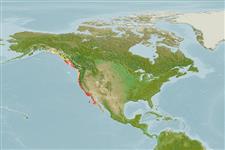Environment: milieu / climate zone / depth range / distribution range
Ecology
Marine; demersal; depth range 15 - 128 m (Ref. 2850), usually 30 - 46 m (Ref. 2850). Subtropical; 12°C - 25°C (Ref. 131080); 60°N - 27°N, 145°W - 113°W
Eastern Pacific: Puget Sound, Washington, USA to central Baja California, Mexico; but doubtful north of California.
Length at first maturity / Size / Weight / Age
Maturity: Lm 20.0, range 15 - ? cm
Max length : 36.0 cm TL male/unsexed; (Ref. 2850); max. reported age: 14 years (Ref. 39277)
Caught fairly often by sport fishers using small hooks (Ref. 2850). Adults feed on tiny fishes. mysids, krill, and other crustaceans (Ref. 131080). Viviparous (Ref. 34817).
Eschmeyer, W.N., E.S. Herald and H. Hammann, 1983. A field guide to Pacific coast fishes of North America. Boston (MA, USA): Houghton Mifflin Company. xii+336 p. (Ref. 2850)
IUCN Red List Status (Ref. 130435: Version 2024-2)
Human uses
Fisheries: commercial; aquarium: public aquariums
Tools
Special reports
Download XML
Internet sources
Estimates based on models
Preferred temperature (Ref.
123201): 8 - 11.8, mean 9 °C (based on 12 cells).
Phylogenetic diversity index (Ref.
82804): PD
50 = 0.5000 [Uniqueness, from 0.5 = low to 2.0 = high].
Bayesian length-weight: a=0.01000 (0.00495 - 0.02022), b=3.09 (2.92 - 3.26), in cm total length, based on LWR estimates for this Genus-body shape (Ref.
93245).
Trophic level (Ref.
69278): 3.7 ±0.5 se; based on size and trophs of closest relatives
Generation time: 8.9 ( na - na) years. Estimated as median ln(3)/K based on 2
growth studies.
Resilience (Ref.
120179): Low, minimum population doubling time 4.5 - 14 years (tm=6; tmax=14).
Fishing Vulnerability (Ref.
59153): Moderate to high vulnerability (49 of 100).
Nutrients (Ref.
124155): Calcium = 62 [18, 200] mg/100g; Iron = 0.72 [0.30, 1.96] mg/100g; Protein = 18.3 [17.1, 19.5] %; Omega3 = 0.676 [0.290, 1.563] g/100g; Selenium = 58.1 [20.0, 185.4] μg/100g; VitaminA = 30.2 [9.4, 98.7] μg/100g; Zinc = 0.59 [0.30, 1.13] mg/100g (wet weight);
